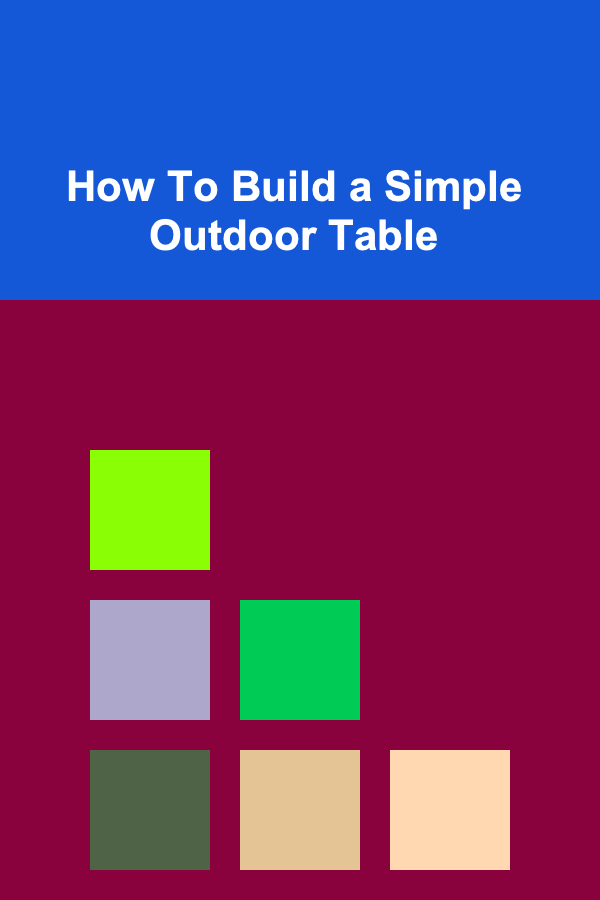
How To Build a Simple Outdoor Table
ebook include PDF & Audio bundle (Micro Guide)
$12.99$10.99
Limited Time Offer! Order within the next:

Building your own outdoor table can be a rewarding and practical project, whether you're looking to add a new centerpiece to your patio, garden, or backyard, or just enjoy the process of creating something by hand. A simple outdoor table doesn't require advanced woodworking skills but can still result in a durable and attractive piece of furniture that will last for years.
This article will guide you through the step-by-step process of building a basic outdoor table, from gathering the necessary materials and tools to completing the final touches. Whether you're a beginner or someone with a bit of experience, this project will provide you with useful tips and a sense of accomplishment once the table is done.
Materials and Tools
Before you begin, it's important to gather all the necessary materials and tools for the project. Here's what you'll need:
Materials:
- Wood Boards: Choose a durable wood that can withstand the elements. Cedar, redwood, or pressure-treated lumber are excellent choices for outdoor furniture due to their resistance to weather and pests.
- Wood Screws: These will be used to attach the pieces together. Make sure they are designed for outdoor use (e.g., galvanized or stainless steel screws).
- Wood Glue: For added stability when attaching the wood pieces together.
- Sandpaper: Use medium to fine-grit sandpaper to smooth out rough edges and surfaces.
- Wood Finish or Sealer: This is important for protecting the table from moisture, UV rays, and other outdoor elements.
- Legs (optional): If you want pre-made legs, you can purchase these from a hardware store or online. Alternatively, you can make your own legs from wood.
Tools:
- Measuring Tape: Accurate measurements are essential.
- Saw: A circular saw or miter saw will make cutting the wood easier. If you don't have access to a power saw, a handsaw will suffice, but it will take longer.
- Drill: To make pilot holes for the screws and assemble the table.
- Screwdriver: For driving screws into the wood.
- Clamps: These are helpful for holding pieces of wood in place while you secure them.
- Paintbrush: To apply wood finish or sealant.
Step-by-Step Instructions
Step 1: Plan and Design
Before you start cutting any wood, it's crucial to plan out your table's dimensions and design. Consider the space where you intend to place the table and how many people you want it to seat. A standard outdoor table for four people typically has dimensions of about 48 inches (120 cm) in length, 24-30 inches (61-76 cm) in width, and 28-30 inches (71-76 cm) in height.
- Measure and Sketch: Draw a rough sketch of your table design. Decide on the length, width, and height of the tabletop, and plan the dimensions for the legs. You can use scrap paper or design software to create a more detailed drawing.
- Select Wood Types: As mentioned earlier, wood types like cedar or redwood are great for outdoor furniture due to their durability. Choose a wood that complements your existing outdoor decor.
- Check Your Work Area: Make sure you have enough space to work safely. Clear the area of any obstructions, and if you're working with large wood boards, ensure you have enough room to make accurate cuts.
Step 2: Cutting the Wood
Once you have your design and materials ready, the next step is to cut the wood pieces according to your measurements.
- Cut the Tabletop: Start by cutting the wood for the tabletop. If you want a rectangular shape, cut two longer pieces (for the length) and two shorter pieces (for the width). For a more natural look, you can choose to join multiple slats together to form the surface.
- Cut the Legs: Cut four equal-length pieces for the legs. For a standard table height, 28-30 inches (71-76 cm) should be sufficient, but adjust the measurements depending on your preferences.
- Cut the Support Beams: You will also need two support beams that will help stabilize the tabletop. These will run perpendicular to the length of the table and should be placed at either end of the table.
- Safety First: Always wear safety goggles and a dust mask when cutting wood, especially if using a power saw. Ensure the wood is firmly secured before cutting to avoid any accidents.
Step 3: Sanding the Wood
After cutting the wood pieces, it's time to sand them down. This step is important for both the look and safety of your table.
- Smooth the Edges: Use medium-grit sandpaper (around 120 grit) to sand the edges of the wood, removing any splinters or rough areas.
- Smooth the Surface: Sand the surface of each piece, starting with a medium-grit sandpaper and finishing with a fine-grit paper (220 grit or higher). This will ensure the surface is smooth and even.
- Pay Attention to the Corners: Round off the sharp edges of the table legs and corners of the tabletop to make it more comfortable and aesthetically pleasing.
Step 4: Assembling the Table
With all your pieces cut and sanded, it's time to assemble the table.
-
Attach the Legs to the Tabletop:
- Place the tabletop upside down on a flat surface.
- Position the four legs at each corner of the tabletop.
- Use wood glue and screws to secure the legs to the tabletop. First, drill pilot holes to prevent the wood from splitting.
- Screw in the screws, making sure they are tight enough to hold the legs in place.
-
Attach the Support Beams:
- Turn the table back upright and attach the two support beams to the underside of the tabletop.
- Position the beams about 5-6 inches (13-15 cm) in from each end of the table.
- Use wood glue and screws to secure them.
-
Check Stability: After the assembly, check for stability. The table should feel firm and secure without wobbling. If needed, adjust the legs or add additional support.
Step 5: Finishing the Table
Now that the basic structure is complete, it's time to finish the table to protect it from the outdoor elements.
-
Apply Wood Sealer or Finish:
- Use a high-quality wood finish or sealer specifically designed for outdoor furniture. This will protect the wood from moisture, UV rays, and temperature changes.
- Apply the finish with a paintbrush in even strokes, making sure to cover all surfaces.
- Allow the finish to dry according to the manufacturer's instructions before applying a second coat (if needed).
-
Optional: Stain or Paint: If you want to add color or further customize the look of the table, you can apply a stain or outdoor paint. Choose a color that complements your outdoor space.
-
Final Inspection: Once the finish has dried completely, do a final inspection of the table. Make sure all screws are tight, and there are no rough edges or areas that need additional sanding or finishing.
Step 6: Enjoy Your New Outdoor Table
With the table assembled and finished, it's time to put it to use! Place it in your desired outdoor space, whether it's your patio, garden, or balcony, and enjoy the fruits of your labor. Consider adding outdoor cushions or decorative pieces to make the table even more inviting.
Tips and Considerations
- Durability: If you live in an area with harsh weather conditions, consider using a more weather-resistant wood like teak or pressure-treated pine. These will last longer and require less maintenance.
- Size Adjustments: Feel free to adjust the dimensions of the table according to your needs. You can make a longer or wider table, or even create a round version if you prefer.
- Creative Additions: You can personalize your table by adding additional features like built-in storage, a hole for an umbrella, or decorative carvings.
Conclusion
Building your own simple outdoor table is a manageable project that can bring a lot of satisfaction. By following these steps, you'll not only create a functional piece of furniture, but you'll also gain valuable woodworking skills that can be applied to other DIY projects. Whether you're a novice or an experienced crafter, this project is a perfect way to enjoy the outdoors and add a personal touch to your home. Happy building!

How to Manage Your Virtual Assistant's Time for Maximum Efficiency in Dropshipping
Read More
How to Reduce Sauces for Concentrated Flavor
Read More
How to Create Profitable Digital Products
Read More
Understanding the Art of Storytelling Through Design
Read More
How to Track Historic Property Valuations for Investment Analysis
Read More
10 Tips for Experiencing a Sporting Event Like a Local
Read MoreOther Products

How to Manage Your Virtual Assistant's Time for Maximum Efficiency in Dropshipping
Read More
How to Reduce Sauces for Concentrated Flavor
Read More
How to Create Profitable Digital Products
Read More
Understanding the Art of Storytelling Through Design
Read More
How to Track Historic Property Valuations for Investment Analysis
Read More